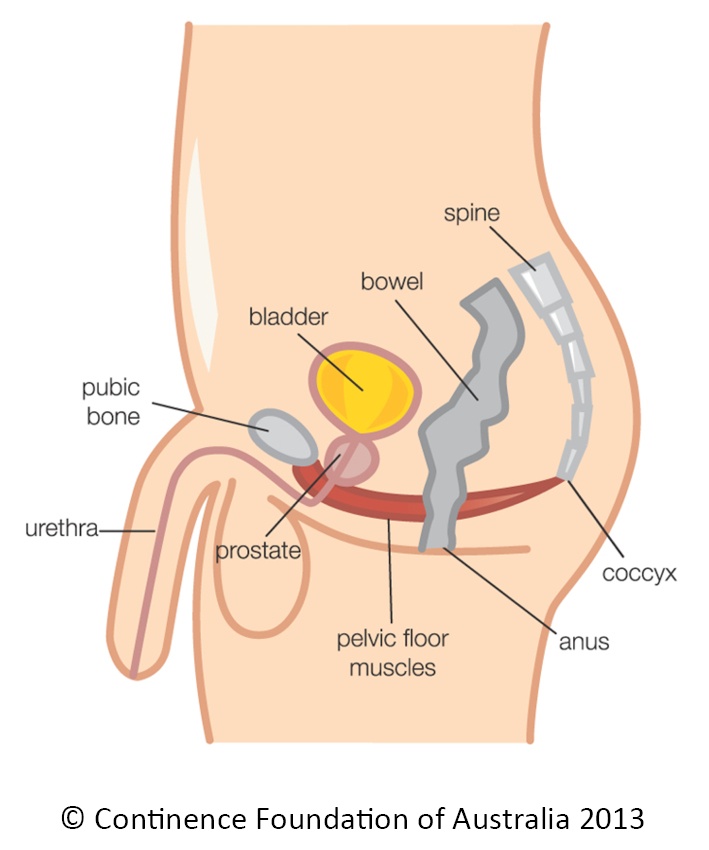Do men have a pelvic floor?
To celebrate Men’s Health Week, let’s flip the focus from the ladies and talk about the male pelvic floor, where it is and what it does.
I get asked this question so often by my patients. Do men have a pelvic floor?
Yes, they most certainly do!![]()
It is not often spoken about or considered as men do not tend to have the same issues with continence that women have.
Why don’t men hear very much about the pelvic floor muscles?
This is because women take the limelight!
Women have a shorter urethra (ie. a shorter funnel for the urine to pass down and leak out of) and undergo a lot of stress and changes to the pelvic floor during pregnancy, childbirth and menopause. This means that problems with the pelvic floor are a much larger issue for females.
Men on the other hand have a longer urethra and a prostate gland which both function to keep them continent and dry most of their life. However in certain situations ie. when the prostate may need to be removed (prostatectomy), men can have serious issues with incontinence because they now have to rely on their pelvic floor muscles…which they may have no idea how to use!

Benefits of a strong pelvic floor
- Reduced chance of urinary or faecal incontinence
- Improved recovery after bowel and bladder surgeries
- Improved erectile function
- Improved urgency control, ie. you don’t have to run to the toilet every 30 minutes
- Improve any issues with dribbling after urination
So ladies, now is the time to get all your husbands, partners, fathers and brothers on board!
Challenge them to a “pelvic-floor” off and see who is stronger!
Guys! Here’s how to turn your pelvic floor on…
For men I suggest lying down or sitting. Relax all your other muscles, remember it should be a secret when you’re doing your pelvic floor exercises!
Now try to imagine a sling of muscle looping around your back passage (anus) and your urethra. Try to tighten this muscle. You should feel a “squeeze and lift” in the area between your scrotum and anus. If this is tricky, try the following prompts…
- Imagine walking in to cold water
- Imagine holding in wind
- Imagine stopping the stream of urine
- “Suck your nuts to your guts”

Still struggling…?
If you still can’t understand how to turn these muscles on, look at yourself in the mirror and see if you can lift the scrotum up and retract the penis… without your tummy muscles sucking in!
If it’s still not working, next time you empty your bladder try and stop the flow of urine mid stream (without using your hands!).
This is a test you can use to understand how your pelvic floor works, but shouldn’t be trialled more than once a week.
If you still are struggling, it may be worthwhile seeing a pelvic floor physiotherapist for proper assessment and training.
Pelvic Floor Exercise Program
If you’ve mastered the art of activating these muscles correctly… try to get in a regular habit of doing these exercises.
Aim to squeeze and hold for 5 seconds
Relax the muscles for 5 seconds.
Repeat x 5-10 times.
Aim to do 3-4 sets/day. Start with lying or sitting, but progress to standing as you feel stronger.
Other pelvic floor health pointers
- Keep your bowels regular and happy. Chronic constipation and straining on the toilet can weaken your pelvic floor. Bowels love a good mixture of fluid, fibre and exercise to keep them happy.
- Chronic coughing can also weaken your pelvic floor. Make sure you get on top of any respiratory conditions.
- Being overweight can place the pelvic floor under excessive strain, so try to maintain a healthy weight range.
- Excessive heavy lifting can also place extra stress on the pelvic floor. Make sure you are using good lifting technique, and keeping your pelvic floor muscles strong to compensate.
It is important for males of any age to learn where these muscles are and how to activate them well.
Pelvic health is just as important for men as it is for women!
Links you might like to check out:
xo Physio Laura

